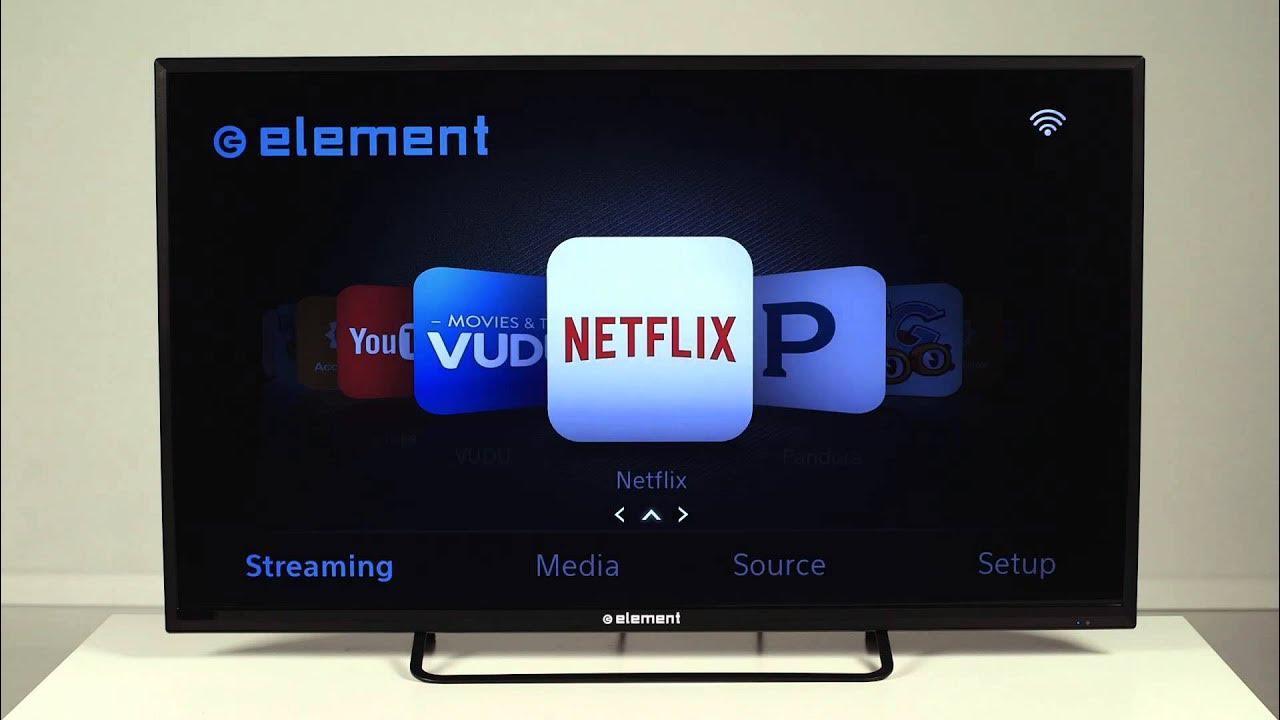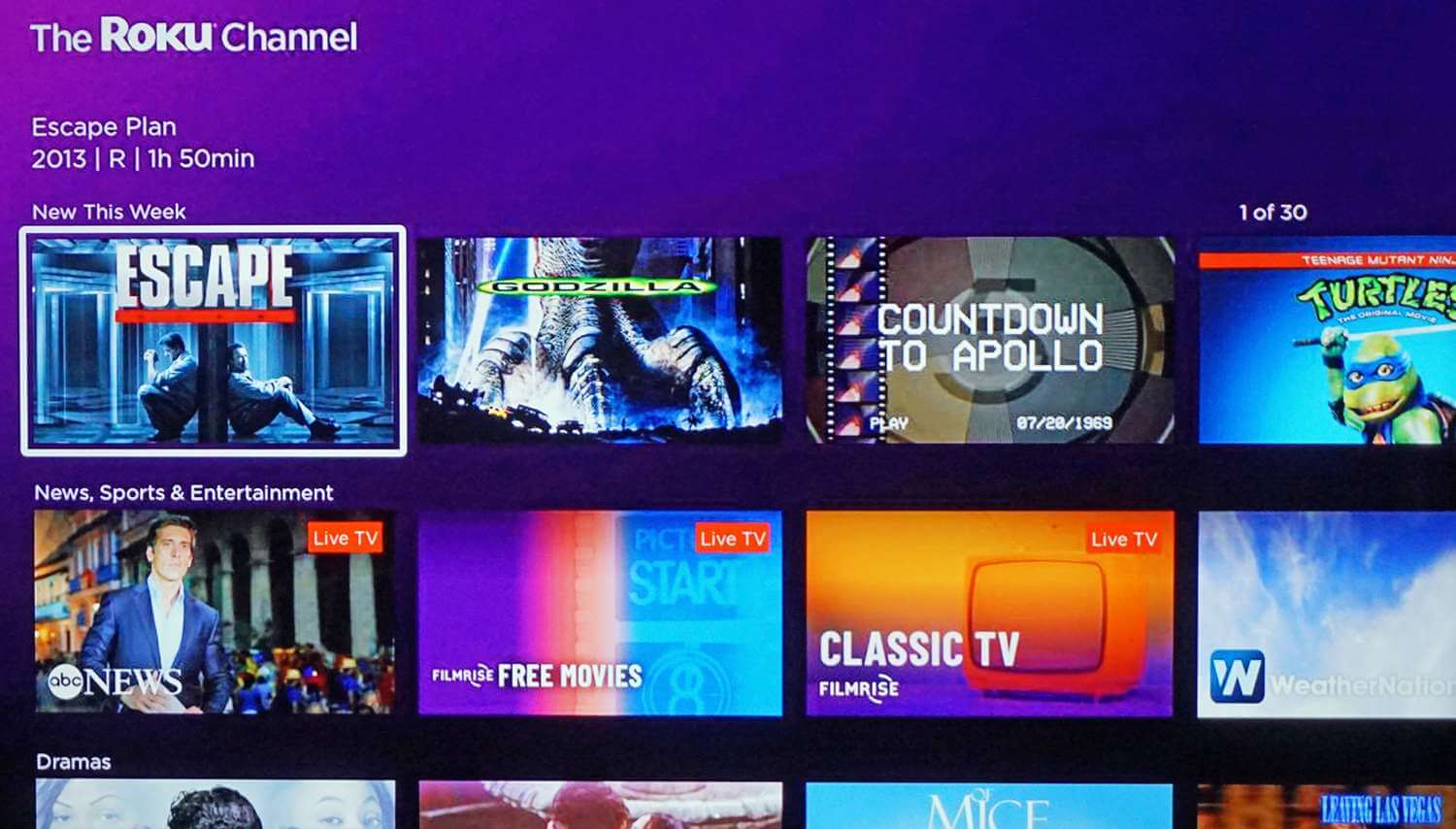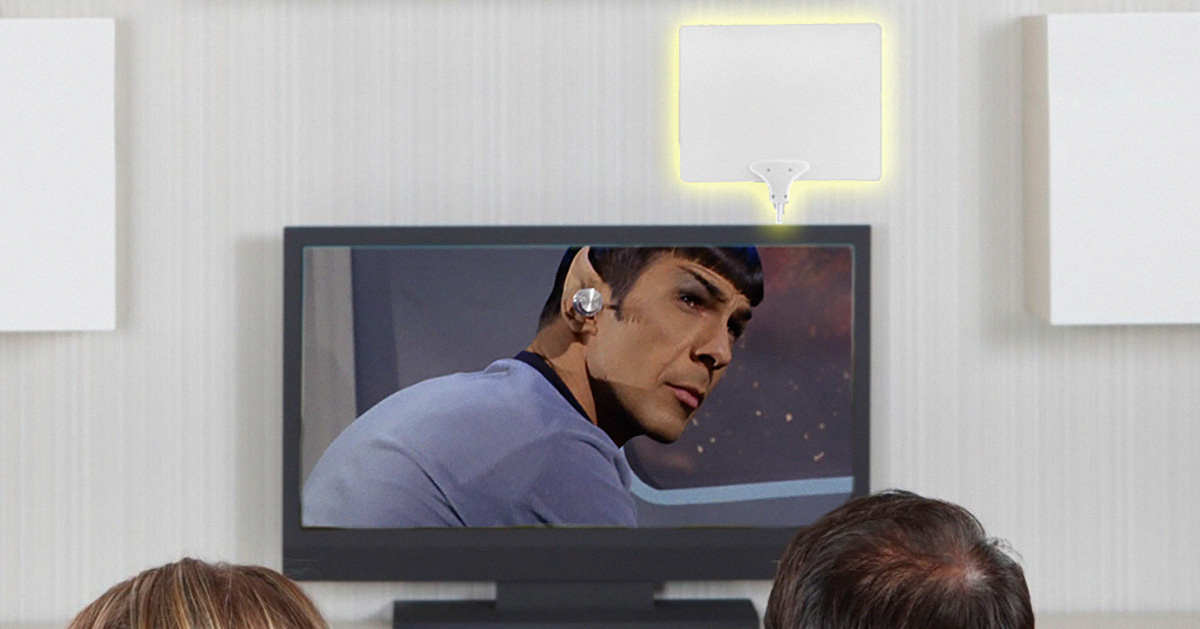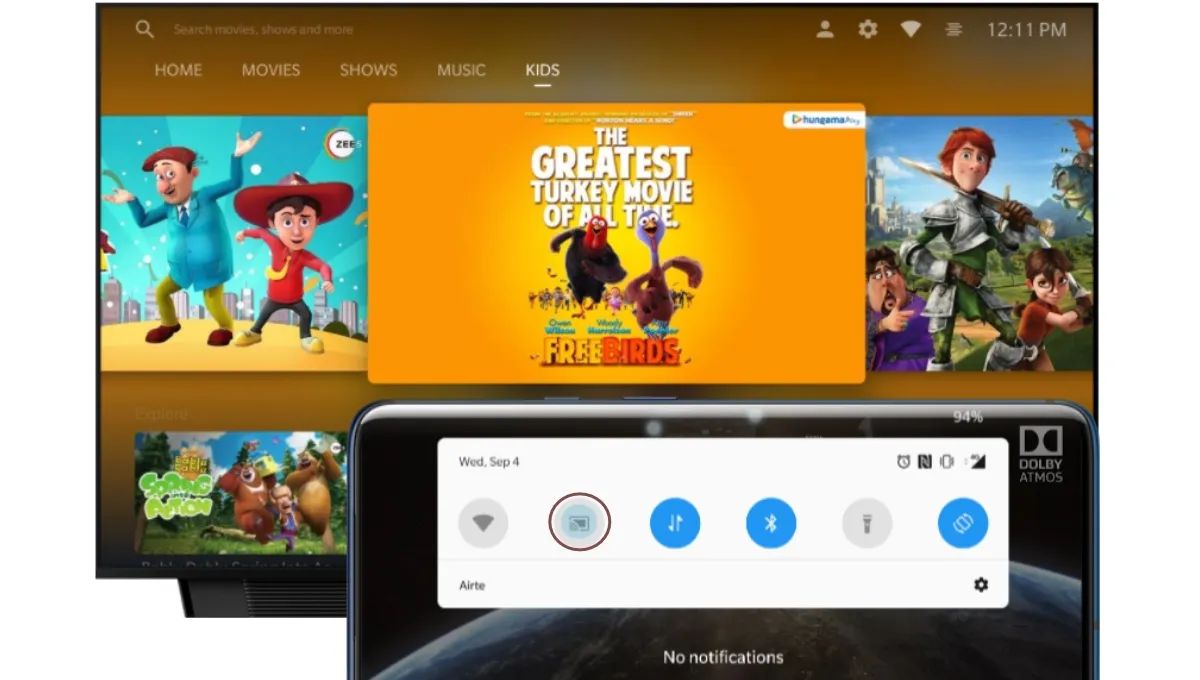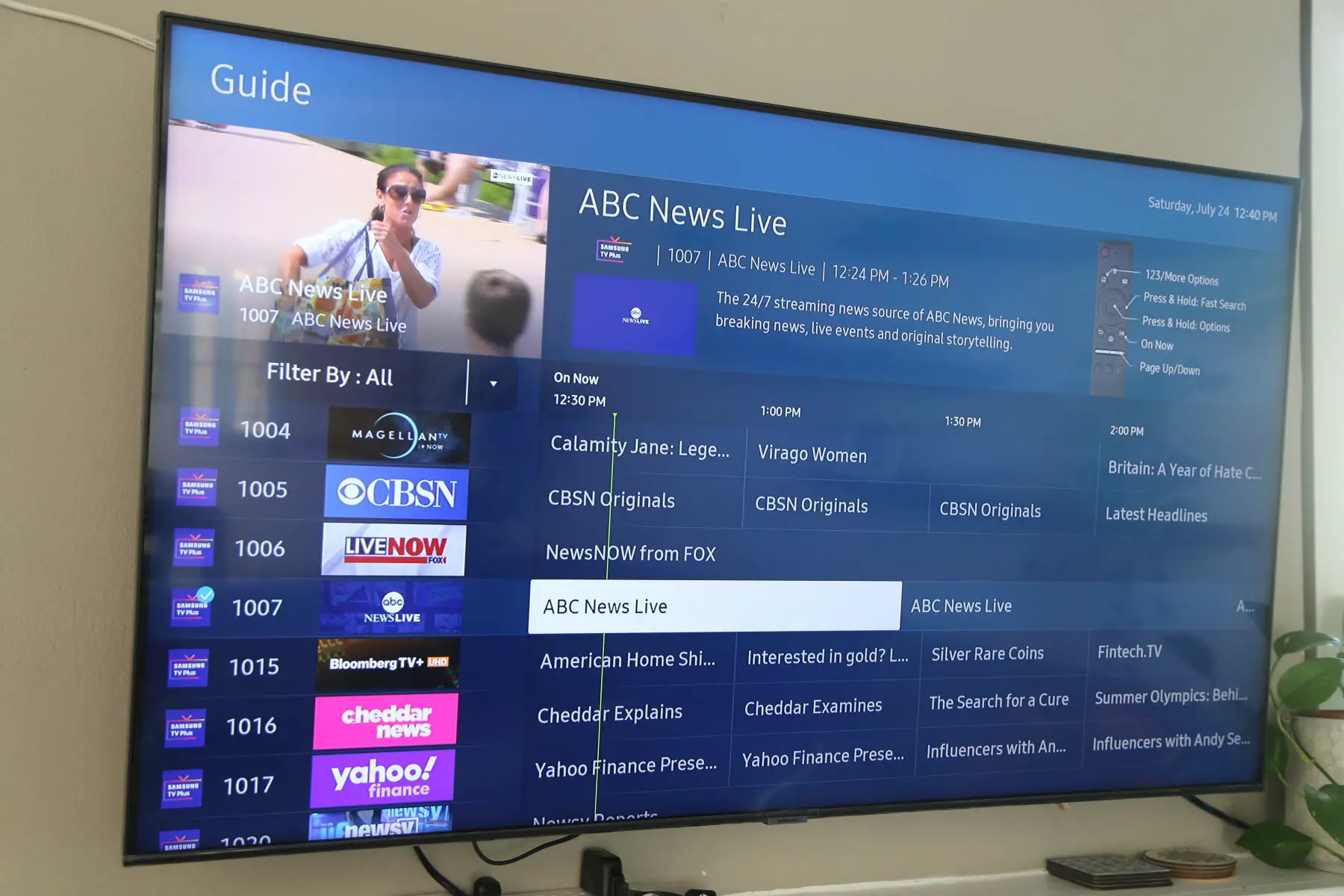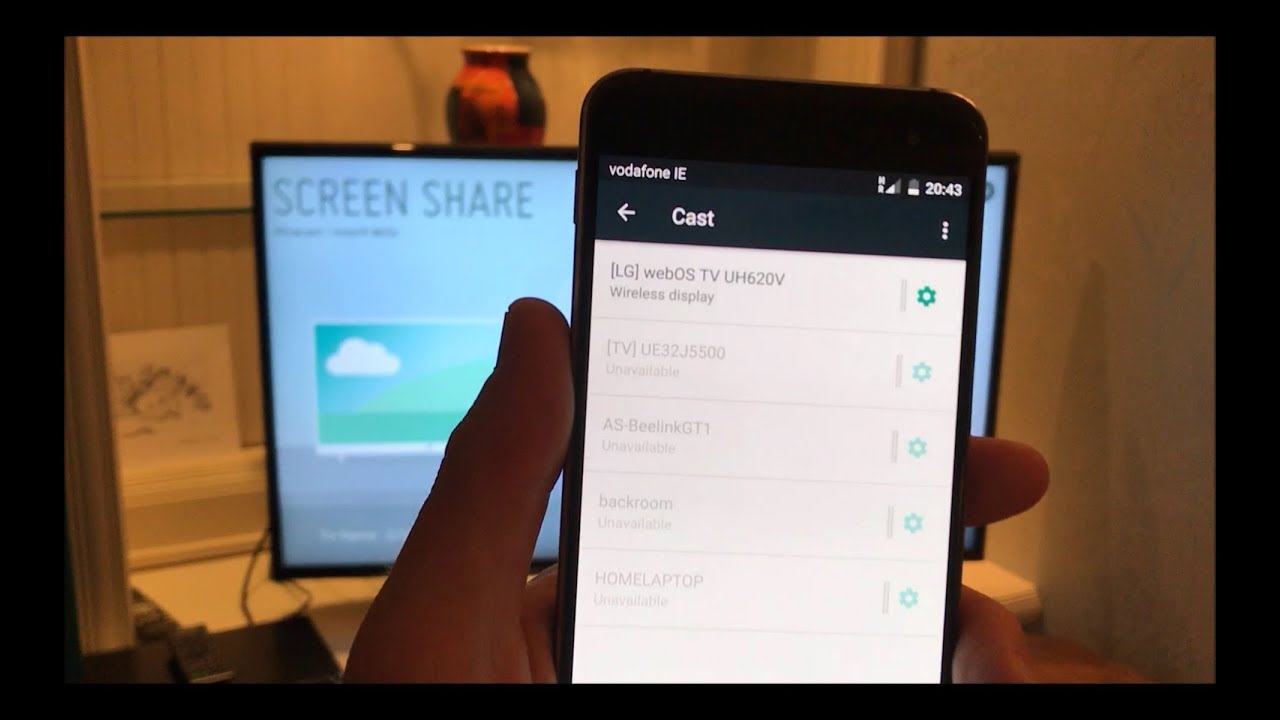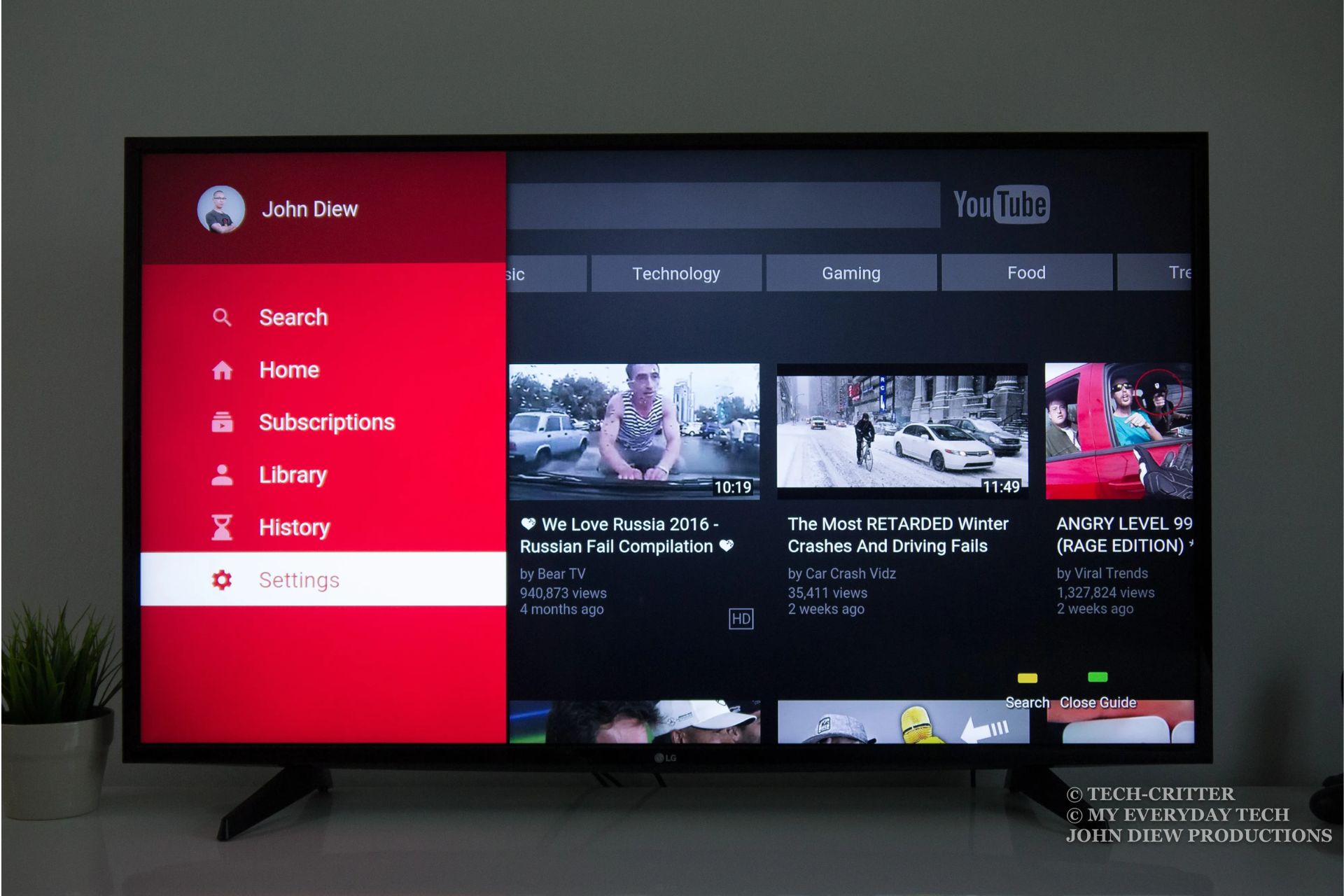Introduction
Welcome to the world of Smart TVs, where entertainment meets technology to bring you a whole new level of television viewing. Gone are the days of traditional TV sets that only allowed you to watch your favorite shows and movies. With a Smart TV, you can do so much more.
So, what exactly is a Smart TV? In simple terms, it is a television set that has built-in internet connectivity and advanced features, allowing you to access a wide range of online content, streaming services, apps, and much more. It is like having a computer integrated into your TV, opening up a world of possibilities.
Connecting your Smart TV to the internet is the first step to unlock its full potential. Once connected, you can stream videos and movies, browse the internet, play games, access social media, and even control your TV with voice commands. The possibilities are endless.
In this guide, we will walk you through everything you need to know to make the most out of your Smart TV. We will cover how to connect your Smart TV to the internet, set up and update your TV, understand the interface, use apps and streaming services, navigate the remote control, adjust settings and preferences, troubleshoot common issues, and answer some frequently asked questions.
Whether you are a tech-savvy individual or a beginner in the world of smart technology, this guide will provide you with the knowledge and tips you need to get the most out of your Smart TV. So, sit back, relax, and let’s dive into the exciting world of Smart TVs!
What is a Smart TV?
A Smart TV is essentially a television set that combines the functionality of a traditional TV with the features and capabilities of a computer. It is equipped with built-in internet connectivity and offers a range of advanced features that enhance your television viewing experience.
Unlike traditional TVs, Smart TVs allow you to access the internet directly from your TV screen, opening up a whole new world of entertainment options. You can stream your favorite movies and TV shows from popular streaming services like Netflix, Hulu, and Amazon Prime Video, eliminating the need for external devices like a streaming stick or set-top box.
Smart TVs also come equipped with a variety of apps, similar to those found on smartphones and tablets. These apps allow you to access popular social media platforms, browse the web, play games, listen to music, and even control other connected devices in your smart home.
One of the key features of a Smart TV is its ability to connect to the internet via Wi-Fi or an Ethernet cable. This connectivity allows you to download software updates, ensuring that your TV is always up to date with the latest features and improvements.
Another advantage of Smart TVs is their user-friendly interface. Most Smart TVs feature a home screen that displays a grid or carousel of apps and services, making it easy to navigate and find what you’re looking for. Some models even offer voice control capabilities, allowing you to control your TV using voice commands.
Smart TVs also offer a range of connectivity options, including HDMI ports, USB ports, and audio jacks, allowing you to connect external devices such as gaming consoles, Blu-ray players, soundbars, and speakers.
Overall, a Smart TV opens up a world of possibilities, allowing you to personalize your viewing experience, access a wide range of content and services, and enjoy the convenience of a connected entertainment system.
Connecting Your Smart TV to the Internet
Connecting your Smart TV to the internet is a crucial step in unlocking its full potential and accessing a wide array of online content and services. Here’s a step-by-step guide on how to connect your Smart TV to the internet:
- Check your TV’s internet connectivity options: Before you begin, make sure to check the available internet connectivity options on your Smart TV. Most Smart TVs support both Wi-Fi and Ethernet connections. If you prefer a wired connection, you can connect an Ethernet cable from your router to the Ethernet port on the TV. For a wireless connection, ensure that your TV has built-in Wi-Fi capabilities or connect a Wi-Fi adapter if required.
- Access the network settings: On your Smart TV, navigate to the settings menu. Look for the network or internet settings and select it. This will take you to the network setup options.
- Choose the connection type: In the network settings, you will typically see options for wired or wireless connections. Select the appropriate option based on your preferred method of connecting to the internet.
- Wi-Fi connection: If you opt for a Wi-Fi connection, the Smart TV will scan for available networks. Select your home Wi-Fi network from the list and enter your Wi-Fi password when prompted. Once connected, the TV will display a confirmation message.
- Ethernet connection: If you choose a wired connection, connect one end of the Ethernet cable to your router and the other end to the Ethernet port on the TV. The TV should automatically detect the wired connection and establish a connection to the internet.
- Test the connection: After establishing the internet connection, it’s essential to test its stability and speed. Most Smart TVs have a built-in network test or speed test feature. Use this feature to ensure that your connection is strong and reliable.
- Update your Smart TV: Once you’re connected to the internet, it’s a good practice to update your Smart TV to ensure that you have the latest firmware and software versions. This can usually be done through the settings menu or the system update section of your TV.
By following these steps, you can easily connect your Smart TV to the internet and start enjoying the endless possibilities it has to offer.
Setting Up and Updating Your Smart TV
Once you have connected your Smart TV to the internet, the next step is to set it up and ensure that it is running on the latest software version. Here’s a step-by-step guide on how to set up and update your Smart TV:
- Initial setup: When you first turn on your Smart TV, you will be guided through an initial setup process. This usually involves selecting your language, region, and agreeing to the terms and conditions. Follow the on-screen prompts to complete the setup.
- Network settings: During the initial setup or in the settings menu, you may need to review and configure your network settings. Ensure that your Smart TV is connected to your home Wi-Fi network or the appropriate Ethernet connection.
- Software update: Once connected to the internet, it is essential to check for and install any available software updates. These updates often include bug fixes, security patches, and new features. Navigate to the settings or system update section of your Smart TV and initiate a software update check. If an update is available, follow the prompts to download and install it.
- App updates: In addition to software updates, you should also check for updates for individual apps installed on your Smart TV. This ensures that you have the latest versions with any bug fixes or new features. Open the app store or the settings section of your Smart TV, look for the app update option, and follow the instructions to update your apps.
- Adjusting picture and audio settings: To optimize your viewing experience, take some time to adjust the picture and audio settings on your Smart TV. This includes adjusting brightness, contrast, color, and audio settings according to your preferences.
- Customizing the home screen: Most Smart TVs allow you to customize the home screen to prioritize your favorite apps and content. Rearrange app icons, remove unused apps, and add shortcuts to frequently used features or streaming services. This will make navigating your Smart TV more efficient and personalized.
- Parental controls: If you have children or want to restrict certain content, you can set up parental controls on your Smart TV. This feature allows you to block specific channels, programs, or apps based on age ratings or content categories.
By following these setup steps and keeping your Smart TV updated, you can ensure a smooth and optimized user experience. Take the time to explore your TV’s settings and features to make the most out of your Smart TV entertainment.
Understanding the Smart TV Interface
The interface of a Smart TV is designed to provide a user-friendly and intuitive way to navigate through various apps, services, and features. Understanding how to navigate the Smart TV interface is essential for a seamless and enjoyable viewing experience. Here are some key aspects to help you navigate through your Smart TV:
- Home Screen: The home screen is the starting point of your Smart TV interface. It serves as a hub for accessing your installed apps, recommended content, recently watched shows or movies, and other personalized features. It may consist of a grid or carousel-style layout, displaying app icons or content thumbnails.
- App Store: Just like on a smartphone or tablet, Smart TVs often have an app store available. This is where you can browse and download additional apps to enhance your viewing experience. The app store offers a variety of categories, such as streaming services, news, sports, games, and more.
- Navigation: Smart TVs typically provide a variety of ways to navigate through the interface. This may include using the arrow buttons on your remote control, a touchpad or gesture control, or even voice commands. Familiarize yourself with the available navigation options and choose the one that suits you best.
- Search Functionality: Most Smart TVs have a search function that allows you to quickly find specific shows, movies, or apps. You can use the search function by typing with an on-screen keyboard or using voice search. This feature simplifies the process of finding content across various apps and streaming services.
- Recommendations: Smart TVs often provide personalized recommendations based on your viewing history and preferences. These recommendations are displayed on the home screen and suggest shows, movies, or apps that you may enjoy. Take advantage of these recommendations to discover new content.
- Settings: The settings menu is where you can customize various aspects of your Smart TV. This includes adjusting picture and audio settings, managing network and connectivity options, setting parental controls, and more. Explore the settings menu to personalize your Smart TV experience and make adjustments according to your preferences.
- Quick Access Buttons: Some Smart TVs have dedicated buttons on the remote control for quick access to specific functions or apps. These buttons allow you to directly launch popular apps like Netflix, YouTube, or Amazon Prime Video, saving you time and providing easy access to your favorite content.
By familiarizing yourself with the Smart TV interface and its different features, you can easily navigate through the menus, access your desired apps, find content quickly, and personalize your viewing experience. Take the time to explore and customize your Smart TV interface to make it truly your own.
Using Apps and Streaming Services
One of the biggest advantages of a Smart TV is the ability to access a wide range of apps and streaming services directly from your television. With a multitude of options available, you can easily customize your entertainment experience. Here’s how to make the most of apps and streaming services on your Smart TV:
- App Store: Start by exploring the app store on your Smart TV. This is where you can find and download a variety of apps. Popular streaming services like Netflix, Hulu, Amazon Prime Video, Disney+, and YouTube often have dedicated apps available. Additionally, you can find news, sports, gaming, and other lifestyle apps to enhance your Smart TV experience.
- Signing in: Once you have downloaded an app from the app store, launch it and sign in using your existing account credentials. Most apps require a subscription or login to access their content. If you don’t have an account, follow the prompts to create one directly on your Smart TV or use your computer or smartphone to sign up and then sign in on your TV.
- Exploring content: Each streaming service app offers a vast library of movies, TV shows, documentaries, and other content. Use the app’s search and browse functions to discover new content. Many apps also provide personalized recommendations based on your viewing history and preferences.
- Playing and controlling content: Once you’ve found something to watch, select it and enjoy. Use the playback controls on your TV remote to pause, play, rewind, or fast-forward through the content. Some apps also allow you to create playlists, add to your watchlist, or save content for offline viewing.
- Multiple user profiles: Streaming service apps often support multiple user profiles. This feature is convenient if you share your Smart TV with family members. Each profile can have its own personalized recommendations and settings, ensuring that everyone gets a tailored viewing experience.
- Screen mirroring and casting: Smart TVs often support screen mirroring or casting, allowing you to mirror the screen of your smartphones, tablets, or laptops onto the TV. This feature is great for displaying photos, videos, presentations, or even playing games on the big screen.
- Updating apps: It’s important to regularly update your apps on your Smart TV to ensure you have access to the latest features and improvements. Check the app store or the settings section on your TV for app update options.
By utilizing apps and streaming services on your Smart TV, you can access a world of content and take your entertainment experience to the next level. Whether you want to binge-watch your favorite Netflix series or discover new movies on Amazon Prime Video, the possibilities are endless.
Smart TV Remote Control Guide
The remote control is your gateway to navigating and controlling your Smart TV. Understanding the functions and features of the remote control is essential for a seamless and user-friendly TV experience. Here’s a guide to help you make the most out of your Smart TV remote:
- Power button: The power button is used to turn your Smart TV on or off. Pressing this button will either power up or shut down the TV.
- Navigation buttons: The navigation buttons typically consist of an up, down, left, and right arrow. Use these buttons to navigate through the Smart TV interface, select apps, or browse through content.
- Enter/select button: The enter or select button is used to confirm your selection or choice. When navigating through menus or apps, press this button to open or select an item.
- Home button: The home button takes you back to the home screen of your Smart TV. Pressing this button from any screen or app will return you to the main screen.
- Back button: The back button is used to go back to the previous screen or exit from a menu or app. It helps you navigate backward through the interface.
- Volume and mute buttons: The volume up, volume down, and mute buttons control the audio output of your Smart TV. Use them to adjust the volume or mute/unmute the sound.
- Channel buttons: If your Smart TV has traditional TV channels, the channel buttons allow you to change channels. Use the channel up and channel down buttons to scroll through different channels.
- Source/input button: The source or input button lets you switch between different inputs on your Smart TV, such as HDMI, USB, or antenna. Press this button to access the different input options available.
- Numeric keypad: The numeric keypad allows you to directly enter channel numbers or perform specific actions based on the on-screen prompts.
- Smart features: Depending on your Smart TV model, you may have dedicated buttons for accessing specific apps or smart features. These buttons offer quick access to popular streaming services like Netflix, YouTube, or Amazon Prime Video.
- Voice control: Some Smart TV remotes come equipped with a voice control feature. You can use this feature to search for content, adjust settings, or even control other connected devices using voice commands.
Become familiar with the functions and layout of your Smart TV remote control. It will enable you to navigate through the interface, control the volume, switch inputs, and access various features with ease. Use the remote control as your tool to customize and enhance your Smart TV viewing experience.
Adjusting Settings and Preferences
Customizing the settings and preferences on your Smart TV allows you to tailor your viewing experience to your liking. Here are some key settings and preferences that you can adjust on your Smart TV:
- Picture settings: Take advantage of the picture settings to optimize the visual quality on your Smart TV. Adjust settings such as brightness, contrast, color temperature, sharpness, and backlight to suit your preferences. Some TVs may also offer advanced features like HDR (High Dynamic Range) or local dimming for enhanced picture quality.
- Audio settings: Customize the audio settings to enhance the sound quality on your Smart TV. You can adjust settings such as volume, bass, treble, balance, and equalizer to suit your audio preferences. Additionally, some TVs may offer sound modes or settings specific to different types of content, such as movies, music, or sports.
- Display and aspect ratio: Adjust the display settings to fit your TV screen and content. You can choose the aspect ratio to ensure that the content is displayed correctly. Additionally, you can enable features like overscan or screen fit to eliminate any black borders or cutoff edges.
- Network and connectivity: Explore the network and connectivity settings to manage your internet connection and other connected devices. You can configure Wi-Fi settings, set up wired connections, or connect Bluetooth devices. Additionally, you may have options to enable or disable features like screen mirroring or DLNA (Digital Living Network Alliance) for easy content sharing.
- Accessibility settings: Smart TVs often offer accessibility settings to accommodate users with specific needs. You can adjust settings such as closed captions, audio descriptions, text-to-speech, or high contrast modes to enhance accessibility and ensure an inclusive viewing experience.
- Parental controls: If you have children or want to restrict certain content, you can set up parental controls on your Smart TV. These controls allow you to block specific channels, shows, or apps based on age ratings or content categories. You can also set up PIN protection to prevent unauthorized access.
- Smart assistants: If your Smart TV supports voice control or smart assistants like Google Assistant or Amazon Alexa, you can set up and configure these features. This allows you to control your TV, search for content, and access other smart devices using voice commands.
- App settings: Individual apps on your Smart TV may have their own settings that you can adjust. Explore the settings within each app to personalize your experience. For example, you can set video quality preferences, enable or disable autoplay, or adjust subtitles options within streaming service apps.
By adjusting settings and preferences on your Smart TV, you can create a personalized and optimized viewing experience. Take the time to explore these settings and make adjustments according to your preferences and needs. Experiment with different settings to find the perfect balance for an enjoyable and immersive TV experience.
Troubleshooting Common Smart TV Issues
While Smart TVs offer a wealth of features and benefits, they can occasionally encounter issues that may disrupt your viewing experience. Here are some common Smart TV issues and troubleshooting steps to help you resolve them:
- Internet connectivity problems: If your Smart TV is unable to connect to the internet, check your Wi-Fi or Ethernet connection. Ensure that your network is working correctly and that the TV is within range. You can also try power cycling your router and restarting your Smart TV. If the issue persists, adjusting the network settings or contacting your internet service provider (ISP) may be necessary.
- Noisy or distorted picture: If you’re experiencing a noisy or distorted picture on your Smart TV, check the cable connections to make sure they are secure and undamaged. Adjust the picture settings on your TV to improve the image quality. If the issue continues, there may be a problem with the source device or the TV’s hardware. Consider testing different HDMI cables, devices, or contacting the manufacturer for further assistance.
- No sound or audio issues: If you have no sound coming from your Smart TV, ensure that the volume is not muted and is set to an audible level. Check the audio settings on your TV and make sure they are properly configured. Verify that the cables connecting external speakers or sound systems are properly plugged in. If the problem persists, try connecting different audio devices or consult the manufacturer’s support for further guidance.
- App malfunctions or crashes: If an app on your Smart TV is malfunctioning or crashing, start by force closing the app and reopening it. Check if there are any available updates for the app and install them. If the issue continues, uninstall and reinstall the app. In some cases, clearing the cache and data associated with the app can also resolve the problem. If all else fails, contact the app developer or the TV manufacturer for assistance.
- Remote control issues: If your Smart TV remote control is not functioning properly, try replacing the batteries or resetting the remote. Ensure there are no obstructions between the remote and the TV. If the issue persists, consider pairing the remote control with the TV again or getting a replacement remote. Alternatively, you can use a compatible universal remote control to operate your Smart TV.
- Slow performance or freezing: If your Smart TV is experiencing slow performance or freezing, try closing unnecessary apps running in the background. Clear the cache and data of apps regularly to optimize performance. Restart your TV to refresh the system. If the issue continues, consider updating the TV’s software to the latest version or contacting the manufacturer for further troubleshooting steps.
- Remote streaming issues: If you encounter buffering or streaming issues while watching content on apps, check your internet connection speed. Ensure that you have a stable and fast internet connection. Position your router closer to the TV or use a Wi-Fi extender to improve signal strength. If multiple devices are connected to the network, consider disconnecting some of them to allocate more bandwidth for streaming.
If you encounter any other issues with your Smart TV that are not mentioned here, refer to the user manual or contact the manufacturer’s customer support for further assistance. They will be able to guide you through specific troubleshooting steps tailored to your Smart TV model.
Frequently Asked Questions about Smart TVs
As Smart TVs continue to gain popularity, many people have questions about their features, functionalities, and usage. Here are some frequently asked questions about Smart TVs:
- Can I turn my regular TV into a Smart TV? Yes, you can turn your regular TV into a Smart TV by connecting external devices such as a streaming stick, set-top box, or gaming console that offers Smart TV functionality. These devices can provide internet connectivity and access to various streaming services and apps.
- Do I need an internet connection for a Smart TV? Yes, an internet connection is required for a Smart TV to take full advantage of its features and capabilities. You need internet connectivity to stream content, download apps, and receive software updates.
- Are Smart TVs secure? Smart TVs, like any internet-connected device, can have security vulnerabilities. It is important to follow security best practices, such as keeping your TV’s software updated, using strong passwords, and being cautious about downloading apps from untrusted sources. Additionally, some Smart TVs offer built-in security features, such as antivirus software or data encryption.
- What streaming services can I access on a Smart TV? Smart TVs typically support popular streaming services like Netflix, Hulu, Amazon Prime Video, Disney+, YouTube, and many more. The availability of specific streaming services may vary depending on your region and the model of your Smart TV.
- Can I use my smartphone or tablet to control my Smart TV? Yes, many Smart TVs have companion apps that allow you to control your TV using your smartphone or tablet. These apps provide remote control functionality, as well as additional features like voice search and content casting.
- Can I connect my Smart TV to external devices like gaming consoles or sound systems? Yes, Smart TVs typically have multiple HDMI ports, USB ports, and audio jacks, allowing you to connect external devices like gaming consoles, Blu-ray players, soundbars, or speakers. These connections enhance your viewing and audio experience.
- Can I watch live TV on a Smart TV? Yes, you can watch live TV on a Smart TV by connecting an antenna or subscribing to a streaming service that offers live TV channels. Additionally, some Smart TVs have built-in digital tuners that allow you to directly receive over-the-air broadcast signals.
- Can I download additional apps on my Smart TV? Yes, most Smart TVs have an app store or marketplace where you can browse and download additional apps. These apps can extend the functionality and entertainment options of your Smart TV.
- Can I use voice commands with my Smart TV? Smart TVs equipped with voice control features allow you to use voice commands to search for content, control settings, and interact with your TV. Some Smart TVs have built-in voice assistants like Google Assistant or Amazon Alexa, while others may require additional devices like smart speakers to enable voice control.
- Does every TV have the same Smart TV features? No, Smart TV features can vary depending on the brand, model, and year of manufacture. Different Smart TVs may have different operating systems, app selections, and functionalities. It is important to research and compare different models before making a purchase.
If you have any further questions about Smart TVs, refer to the user manual provided with your TV or contact the manufacturer’s customer support for assistance. They will be able to provide you with specific information and guidance related to your Smart TV model.
Conclusion
Smart TVs have revolutionized the way we enjoy entertainment in our homes. With their internet connectivity, built-in apps, and advanced features, they have become a central hub for accessing a wide range of content and services. By following the steps outlined in this guide, you can make the most out of your Smart TV and enhance your viewing experience.
Connecting your Smart TV to the internet allows you to access streaming services, browse the web, and enjoy interactive features. Setting up and updating your Smart TV ensures that you have the latest software and firmware to enjoy all the features and improvements. Understanding the Smart TV interface enables you to navigate through apps, customize your home screen, and find content easily.
Using apps and streaming services on your Smart TV opens up a world of entertainment options. From watching your favorite shows and movies to exploring new content, the possibilities are endless. The Smart TV remote control is your tool to navigate through the interface, control settings, and access different features.
Adjusting settings and preferences allows you to personalize your Smart TV experience. Customizing picture and audio settings, managing network and connectivity options, and setting parental controls ensure that your Smart TV is tailored to your preferences and needs.
If you encounter any issues with your Smart TV, refer to the troubleshooting section for common problems and their solutions. Additionally, the frequently asked questions section provides answers to common queries about Smart TVs.
Now that you are equipped with the knowledge of how to use your Smart TV effectively, go ahead and enjoy the limitless entertainment options it offers. Sit back, relax, and immerse yourself in a whole new world of entertainment right from the comfort of your living room.







